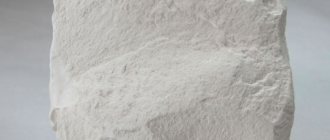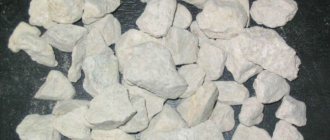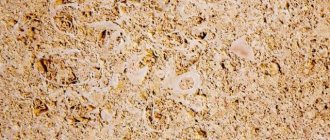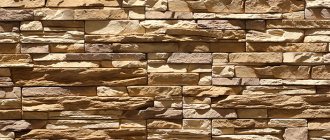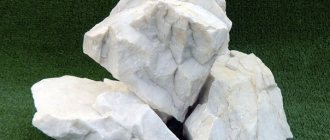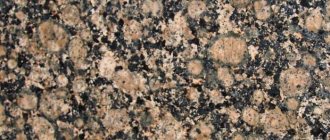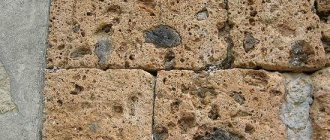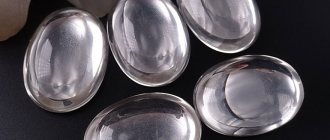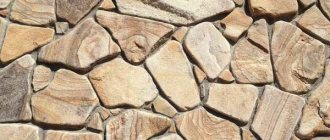Limestones are familiar to every person. At first it seems that this stone is not at all interesting or attractive. However, we will try to prove that this is not so!
Limestone stone does not have a variety of colors and is often found in mountain ranges. What is the distinctive feature of limestone? This stone is easy to work with and includes a wide range of textured surfaces and natural patterns. In addition, it left a significant imprint on culture and history: the Great Wall of China, the Moscow Kremlin, the pyramids of the ancient Egyptians and other structures.
What is limestone?
Limestone is a sedimentary rock, the composition of which is maximally saturated with the content of calcite and impurities.
The material also contains particles of silicon, lime, quartz, phosphates and other substances that help reduce porosity and increase strength. Limestone is usually grey, beige, sandy or yellowish. However, some varieties of the breed are colored red, green and brown. Mineralogists attribute this color change to the presence of manganese and iron impurities in some limestone rocks.
Features of education
The formation of such rocks occurred in different geological eras; this is due to the accumulation of shells of ancient inhabitants of seas and reservoirs on the seabed. This explains the fact that entire shells or animal prints can be found in the rock. Such limestone is also called shell rock. It is compressed under pressure and changes its structure, becoming homogeneous crystalline. This promotes the formation of dense limestone.
Story
Limestone rocks began to form a hundred million years ago. As a result of the accumulation of biological sediments in shallow seas and lakes, favorable conditions were formed for the appearance of calcium carbonate. Strong winds, hurricanes, storms and currents naturally crushed seashells, stones, and corals. The resulting sand eventually combined with sediments and formed limestone, which later, due to the strong pressure of depth, became compacted and, under the movement of tectonic plates, reached the surface of the Earth.
The grayish material was noticed by ancient people and they began to use it to arrange and strengthen their homes in caves. Since then, limestone has been perceived as a durable building material, from which walls, monuments, sculptures and much more were erected. The cultural monuments, created from limestone many centuries ago, are still in good condition. These are the Egyptian pyramids, the Chinese Wall and the Kremlin in Moscow.
The widespread distribution of the rock has allowed people since ancient times to use limestone in various fields. Hardened chalk-like specimens have been used to write and create rock art since primitive times. Limestone rock helped them strengthen their homes and retain heat indoors. It was here that primitive people brought prey from hunting and held councils of elders in caves. In the course of evolution, they learned the simplest methods of processing rocks. Then, dishes using limestone appeared in the everyday life of ancient communities, and large stones served as tools.
It is known that world-class landmarks known to everyone were built from gray sedimentary rock. For example, Notre Dame Cathedral, Belem Tower in Lisbon, Cathedral of Christ the Savior in Moscow and many others.
Application
In order to understand what limestone is, you need to familiarize yourself with the features of its use. It is used in the areas:
- construction;
- industry;
- Agriculture.
It acts as a flux in metallurgy. It is used in the production of cement and lime, where it is the main component. It is widely used in the food and chemical industries, where it serves as an auxiliary material in production:
- mineral fertilizers;
- calcium carbide;
- soda;
- glass;
- paper;
- Sahara.
Another area of application is the dry distillation of coal, as well as the refining of petroleum products. Lime is used for production:
- plastics;
- rubber;
- putties;
- paints;
- mineral wool;
- medicines;
- soap
Where does the breed come from?
The origin of this material is associated with the activity of ancient rock-forming organisms, during which calcium carbonate is formed from salt water to form skeletons and shells. Less commonly, the material results from chemical precipitation from aqueous solutions or from the evaporation of water. Limestone rock is formed in marine and fresh water bodies, as well as in areas of sea basins and lakes. In nature, limestone occurs in thick layers, reaching sizes of up to a thousand meters. Extraction of limestone layers is carried out using a quarry method, since the rock lies shallow.
Place of Birth
Limestone stone is a very common sedimentary rock. Large deposits of limestone can be found in the structure of the Alpine and Crimean mountains. Large layers of rock lie in the Central region of Russia, as well as in the North Caucasus, Volga region, Baltic states, etc. Limestone stone is mined in the Arkhangelsk, Moscow, Voronezh and Tula regions. Large limestone quarries are being developed in the Krasnodar Territory, Leningrad and Volgograd regions.
The Zhdanovskoye deposit, which was built on the territory of the Russian Federation in the Orenburg region, is considered the richest in limestone. Limestones are mined here and sent to factories in Chelyabinsk and the Urals. It is also worth highlighting the Kemerovo and Novosibirsk regions.
Limestone also occurs outside our country - large deposits have been discovered in America and Australia.
Limestone mining
Before limestone mining begins, an analysis of the rock is carried out, which allows one to determine fragility, porosity and density. This is important to consider when creating quarries to avoid damaging sedimentary rocks. For any mining method, special equipment is used: combines, bulldozers, tractors, conveyors, etc.
Limestone stone is mined in several ways:
- Career. In deposits where large layers of limestone are located, the top soil layer is removed and quarries are developed for extraction. Mining dump trucks are used to transport stone.
- Explosive. In areas where small rock deposits are located, explosion techniques are used. Initially, the top soil and clay are removed from the surface, then special spaces are formed where explosives are placed. As a result of the explosion, contour cracks are formed where limestone is mined in blocks.
- Milling. This method involves the extraction of limestone stone by mechanical means. The rock is crushed, immersed and moved by milling combines.
It is important to note that when extracting limestone, entire layers of the earth's surface are removed. This has a detrimental effect on the ecological situation, as the flora in the area where rock mining is being carried out is destroyed. Therefore, as soon as the quarry is depleted of limestone reserves, it is necessary to carry out reclamation and plant trees.
Explosive method
Limestone is produced using the explosive method. First, you need to open up the deposits, removing earth, clay and substandard limestone from them using bulldozers. Wells are drilled near the edge of the mining site and explosives are placed there. With the help of explosions, layers of limestone are broken off, which then needs to be loaded into dump trucks and taken out for further processing.
Then the quarry where the mining took place is filled with earth and planted with herbs and plants. This method is used in large fields. And in small ones you should not use the explosive method. Then the limestone is removed in blocks similar to the shape of rectangles. This technology is called bar mining.
The work is carried out by different machines that cut stones. An excavator is a must. The technology has its advantages:
- Simplicity.
- Good block shape.
- Easy transportation and handling.
Since limestone has a porous structure, it is used in construction. Temples, palaces, and estates are built from it.
Physico-chemical characteristics
Density – from 2700 to 900 kg/m³. Depends on the deposit and the content of various impurities in the rock: dolomite, quartz and other minerals.
Weight – from 800 to 2800 kg/m³.
Hardness on the Mohs scale – 3.
Limestone dissolves in water.
When heated to temperatures up to 200 °C, it rapidly decomposes. When specially fired, lime is obtained.
Strength under pressure – from 0.4 MPa to 300 MPa.
Limestone is a pure rock with the rock-forming element calcium carbonate (CaCO3). It, in turn, decomposes into calcium oxide (CaO) - 56% and carbon dioxide (CO2) - 44%.
The presence of various minerals in the rock determines the different shades. Limestone is presented in nature in white or gray, although rocks of other colors are also found: blue, light yellow, red and brown. The most unusual is black limestone - it contains petroleum products, which explains the color of the stone.
Classification by diameter of units
In an oolitic structure, the aggregates are usually well sorted by size. In this case, the ratio of the proportion of oolites and cement can vary quite significantly. Nevertheless, in the work “Types of dolomite rocks and their genesis. Issue 4" indicates the proportion of oolites in these rocks at 70-80%.
There is a differentiation of such structures based on the diameter of the aggregates. Thus, most sources agree that the oolitic structure is composed of particles up to 1 mm in size.
Aggregates larger than 2 mm correspond to a pisolite structure. In this case, the sizes of structural elements often differ. Apparently, this division is based on the classification of the structure of sedimentary rocks according to the grain ratio of Frolov (1992). In it, such structures are classified as non-conformal granular (the contours of neighboring grains do not correspond to each other, which does not allow them to completely fill the space, tightly adjacent to each other) and belong to the spherical or spheroaggregate category.
At the same time, VSEGEI identifies 2 types of such structures for limestones, calling them spherical (instead of more than 10 spherical or spheroaggregate in Frolov’s classification). The second type of structure in this category, in addition to oolitic, is oncolitic. It differs from oolitic, first of all, in the significantly larger size of the aggregates (oncolites) - 2-3 cm. Moreover, in such a structure, the cement stands out as a light shade against the background of dark-colored oncolites. Such rocks are characterized by a massive shell-like texture.
Classification of varieties
Types of limestone are classified according to a number of characteristics.
By structure
- crystalline (dense material comparable in structure to marble. Easy to polish due to small pores, not afraid of frost and moisture);
- organogenic-clastic (The material is well processed. This type is called reef limestone, saturated with various remains of marine fauna and fragments of shells. This type of limestone also includes ordinary chalk - a weakly cemented calcium carbonate rock. In life, it received a simple name - shell rock, since this This type of limestone is rich in the presence of organisms of marine fauna. This type of limestone is quite fragile and easily crumbles. Because of this, it is often used for making chalk);
- sintered (this type of limestone is formed in flowing underground reservoirs mainly from insoluble salt, and then compacted under pressure. Limestone stones from stagnant reservoirs are dense. Rocks from flowing water, on the contrary, have a more porous and fragile structure);
- detrital-crystalline (such a stone is an organogenic detritus formed from the remains of fish, shells and animal bones. Unlike other similar materials that have great strength and a low degree of water absorption, this material has low strength and a high degree of water absorption).
By chemical composition
- dolomitized (limestone composition includes on average 4-17% MgO);
- marbled (carbonate limestones, which have a characteristic color - bluish and gray, as well as a high level of organic particles);
- coral (porous and hard limestones formed from pieces of shells in reefs and corals on the seabed);
- clayey (rocks with frequent inclusions of clay and carbonates. They have increased softness and fragility).
By area of application
- flux (a type of limestone characterized by high strength. Used in metallurgy for smelting various metals);
- facing (limestone stone, which is used in construction and for cladding the interiors of premises and buildings).
By origin
- Chemogenic. The process of limestone formation in salt water and underground water sources. The lime precipitates and forms into rock.
- Biogenic. The remains of marine organisms are deposited, which over time turn into carbonate and form limestone.
- Clastic. Various fragments and fragments formed during tides and strong waves represent the composition of clastic limestone
- Mixed. Such limestone is obtained through several processes occurring simultaneously.
Sometimes limestone is exposed to climatic factors, which influence its origin and formation. The increased heating temperature turns the lime into stone limestone with a dense structure. At an intermediate stage of heating, marble can be obtained.
Interesting! One of the manifestations of limestone in nature are stalactites and stalagmites. These are deposits in caves in the form of formations hanging from the ceiling. The shapes of stalactites, which contain limestone, amaze with their beauty and uniqueness. They include small crystals of calcite and show yellowish and pink colors through the transparent top layer.
Limestone deposits in the CIS
Among the CIS countries (except Russia), the most significant limestone deposits are:
- Azerbaijan – Shakhtakhtinskoe deposit, where greyish-yellow and light brown travertine limestones are mined for the manufacture of facing slabs,
- Kazakhstan – Zhetybay limestone deposit, which produces pink, light gray and yellowish shell rock for facing slabs.
Extraction of limestone stone, which can be used for cladding, is not possible in every deposit. Therefore, despite the fact that limestone deposits are found almost everywhere, nevertheless, high-quality finishing stone, combining good aesthetics and operational advantages, is mined in commercial quantities in a relatively small number of deposits.
Where is it used?
According to its characteristics and properties, limestone is a universal material that has found application in manufacturing, agriculture, and also in construction. The choice of stone depends on its origin, physical characteristics and composition. As for the scope of application, it can be very diverse - from interior decoration to exterior cladding.
Due to its unusual porosity, limestone has become a popular material as it is easy to saw and shape into various shapes. Widely used in landscape design and the exterior of various buildings. Indispensable when creating sculptures. For example, in Ancient Rus', stone workers worked with limestone to carve bas-reliefs on slabs.
Widespread use is due not only to ease of processing, but also to other useful properties. Limestone is an environmentally friendly natural material, therefore it does not have a negative effect on the human body. Being a kind of antiseptic, it does not cause allergic reactions or irritations, which is important for people sensitive to this kind of thing.
The type of processing of the rock depends on the type of limestone. Shell rock is easy to trim and saw, so it requires care. If limestone has a dense cementitious composition, it is not processed so easily and requires the intervention of high-power mechanical machines. Limestone slabs that are too porous are subjected to special grouting and grinding, after which they acquire a smooth and polished appearance, suitable for further use.
Another processing method is firing using stoves. This involves a sequential process of heating limestone, at the end of which the rock decomposes into calcium oxide and carbon dioxide. The temperature depends on the type of limestone, and usually reaches 1200 °C. Next, the resulting material is placed in rotary kilns and then cooled. For very hard limestone rocks, shaft stoves are used.
Construction
Some types of stone are strong enough to erect low-rise buildings and even small cottages, but in most cases the stone is used for wall cladding. Limestone stone is used to make wall panels, tiling walls, as well as to create decorative elements - columns, pilasters, bas-reliefs. Small fractions of stone are used as crushed stone in the production of concrete, and large fractions are used for arranging the base of roads and hydraulic systems. Large pieces of rubble stone, which have dimensions of up to 1000 mm, are suitable for the foundation. Crushed limestone is used together with clay to create cement.
An interesting aesthetic feature of limestone is the ability not to lose its certain elite appearance over time. The walls and structures of buildings acquire an antique charm and touch. Another advantage of the breed is the absence, as a rule, of a radioactive background. Walls made of such material breathe well, allowing steam and moisture to pass through, but at the same time having sound insulation. By absorbing solar heat, they prevent unwanted heating of the building, which is important for a person’s comfortable stay in them.
Industry
In this area, limestone is used in glass production as a heat-resistant component. The stone is also used in the chemical industry in the production of rubber, varnish and paints. The material is used in agriculture - limestone additives are purchased as soil fertilizer and livestock feed.
Other areas
Finishing and cladding. Limestone material is used both as an independent material for wall decoration and as a basis for creating decorative interior elements. Profiled stone, which is used to make garden paths and sidewalks, is a ready-made material for installation.
Interior design. Walls, stairs, furniture sets, kitchen countertops and bar counters are made from marbled limestone in rare shades. The elegant stone is ideal for decorating fireplaces, tables and columns. Layered limestone has a convex topography, which is valued by decorators and architects.
Jewelry making. As a rule, craftsmen use stones of pastel and delicate shades to create jewelry. Limestone stones undergo special processing and polishing before turning them into translucent beads. They are used for insertion into pendants, rings, brooches and earrings. The rarest varieties of limestone in their color are used by jewelers to create unique and more expensive jewelry.
Glasswork. Limestone with a loose structure is finely crushed and used as one of the components in the production of heat-resistant glass.
Cretaceous rocks are used in the manufacture of pencils, white chalk, tooth powders, and in the production of paper.
Restrictions
Limestone has a number of disadvantages that limit its use in various fields.
Among the disadvantages:
- absorbs liquid, which violates its strength over time and gradually dissolves the structure of the stone;
- When combined with acids, carbon dioxide comes out of the pores of limestone. This contributes to the decomposition of limestone masses due to precipitation and the entry of acids into groundwater;
Because of these properties, voids may form under buildings built with limestone. To strengthen the structure of the rock during construction, it is impregnated with special water-repellent solutions.
Limestone in architecture and design
Limestone is a very popular material for construction and cladding of buildings. Suitable for cladding facades, as well as for creating decorative elements of the exterior - bas-reliefs, columns and pilasters, brackets. The scope of interior design solutions is quite wide: the manufacture of columns, arches, fireplace portals, limestone finishing of floors and walls, door and window openings. Some types of limestone are suitable for rooms with high humidity (bathrooms, swimming pools).
In landscape design, limestone is used in the design of paths, terraces, decorative walls, fences and the construction of alpine slides (retains heat, allows water and air to pass through, normalizes soil composition).
In our country, domestic limestones, Spanish limestones and German marbled limestones are popular. Due to its relatively low price (compared to other natural stones) and resistance to temperature changes (the number of winter/summer cycles), limestone is the most popular material for finishing the facades of residential complexes and commercial buildings and structures.
The most popular limestones:
Jura Beige
Jura Gray
Jura Rahmweis
Branco Valongo
Branco do Mar
Medicinal properties
Limestone stone is in demand due to not only its construction potential, but also its healing properties. Limestone can be safely called a natural stone, since it has a clean structure from an environmental point of view and an organic composition. That is why it has a beneficial effect on human health:
The material is a natural antiseptic. Limestone disinfects wounds, blocks the spread of infection throughout the body and does not cause irritation and is hypoallergenic. In folk medicine, it is considered beneficial to drink water that has been purified with calcite, i.e. limestone. This solution helps improve digestion and cleanse the body of harmful toxins. Limestone is added to special solutions and applied to walls in order to get rid of dampness and fungus.
Important! The healing characteristics of limestone are usually distinguished depending on its color. Thus, yellow stones have a beneficial effect on mental health and are often used in meditation; red ones are applicable for problems with the nervous system; blue limestone reduces blood pressure, and pink limestone fights insomnia. To achieve an effective result, a limestone stone is applied to the painful area.
Despite all its beneficial qualities, limestone can also cause harm. If a person frequently comes into contact with limestone, for example during processing or mining, and inhales large amounts of dust from this material, this can adversely affect health and cause respiratory diseases.
Magical influence
Limestone has the same magical properties as calcite. The stone helps develop a person’s clairvoyance abilities - it allows you to see the future and prevent the consequences of wrong decisions and actions of the past. Talismans with limestone endow a person with developed intuition, protect against the envy of others and make a person’s life path easier. In addition, the magical qualities of limestone stone deprive the owner of excessive laziness, apathy and fatigue, and in return give a good mood for a long time and bring success in creativity or career. The stone is often used by women to attract the attention of the man they like. With its energy waves, the stone attracts the opposite sex.
Thanks to its clean energy, limestone helps to cleanse the aura of a home or any premises and improve family life, protecting partners from frequent quarrels and conflicts.
Limestone for zodiac signs
Charms with limestone material are suitable for all zodiac signs except Scorpios. It is believed that people with this zodiac sign have dark energy and are more often directly related to black magic. This is contrary to limestone, since it emits exclusively light energy and has spiritual purity. It is important to note that the rock is not suitable for those zodiac signs whose owners are aggressive, hot-tempered, impatient and strong-willed in nature. For the rest, the stone will give peace, tranquility and bring harmony into their lives. The limestone amulet helps incompatible zodiac signs find a common language and achieve harmony, both in business and in love relationships.
Limestone for professions
Lime stone will benefit people who are constantly faced with information processing, calculations or measurements. For example, engineers, accountants, financiers, etc. Limestone will help people of such professions to concentrate and avoid mistakes and inaccuracies. Calcite is the basis of the rock, capable of developing intuition and attracting attention. Therefore, amulets and various amulets are recommended to be worn by people engaged in activities that require attention and concentration: employees of financial and legal structures, as well as doctors.
It is believed that limestone is a stone of inspiration. He will become an assistant for people of creative specialties. A talisman made of limestone rock will give not only new creative ideas, but also the strength to implement them
About frost resistance and workability
Crystalline limestones are characterized by frost resistance that reaches 400 cycles, but this value changes sharply for limestone of a different structure. The parameter depends on the connection between pores and cracks, as well as the shape. If you are wondering what limestone is, you should also know about workability, which is related to texture and structure. Porous limestone and shell rock can be sawed, but crystalline materials can be easily polished.

